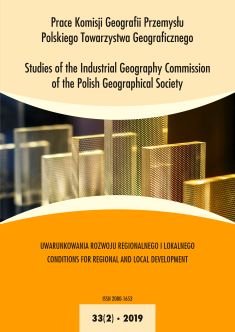The Transformation of Economic Development in the Border Regions of Russia and Kazakhstan in the Post-Soviet Period
DOI:
https://doi.org/10.24917/20801653.332.10Keywords:
border regions, Eurasian Economic Union, integration, Kazakhstan, RussiaAbstract
The prospects and trends for the development of border regions of the former Soviet Union have become one of the profound research areas in the field of economic geography recently. In the conditions of planned economy in the Republics of the USSR, a vertical system of industrial complexes was formed, with the focus on performing national economic tasks. There have been some significant changes in the border regions of independent post-Soviet States in the process of transition to the market economy model. The analysis of the industrial and territorial structure is done on the example of Russia and Kazakhstan. The formation of a common market on the basis of the Eurasian Economic Union allowed the border regions to make the most of their competitive advantage in attracting investments. The unique geographical particularity of the research object is manifested in the fact that there are no analogues of the longest land border in the world as between Russia and Kazakhstan. The new forms of production organisation are implemented in the border regions of the studied countries over more than 7,000 km. More than a quarter of a century later, transformation processes are clearly observed in the mining and manufacturing industries, agriculture, transport and services. As a result, the “regional asymmetry” of industrial development can be observed when manufacturing regions with high added value become the “cores” of economic development of cross-border relations between Russia and Kazakhstan.
Downloads
Metrics
References
Bashmakov, А.А. (2013). From border cooperation to Eurasian economic integration. Alma-Aty: Kazakh Institute of strategic research.
Biidzhanova, E. (2015). Russian and Kazakhstan border territories: social analyses. Economic and social changes: facts, trends and perspectives, 6(42), 224–231.
Bylchak, V. (2014). Theoretical aspects of border economic cooperation on the basis of intergration processes. The Baltic Region, 3 (21), 83–94.
Chasovsky, V. (2014). Transborder economic cooperation between Russian and Belarus regions. Pskov regional journal, 17, 108–117.
Deutsch, K.W. (1968). The Analysis of International Relations, Englewood Cliffs. New Jersey.
Dodonov, V. (2017). Economic collaboration between Kazakhstan and EU and social and rconomic effects. Almaty: Fr, Ebert’s Fund.
Gusev, L., Kazantsev, А. (2015). Russian and Kazakhstan relations: problems and perspectives. Management consulting, 1(73), 29–40.
Guzenkova, T., Sytina, A. (2014). Border ties: resources of Euroasian intergration and interstate collaboration. Problems of national strategy, 1(22), 7–30.
Haas Ernst, B. (1961). International Integration: The European and the Universal Process. International Organization, 15(3), 366–392.
Kaufmann, F-X. (1997). Herausforderungen des Sozialstaates. Frankfurt am Main.
Khnykina, Т. (2016). Perspectives and trends in the development of border cooperation between Russia and Kazakhstan. Samara. Retrieved from https://regrazvitie.ru/wp-content/uploads/ 2016/01/Hnykina.pdf
Lang, W. (1982). Der internationale Regionalismus: Integration und Desintegration von Staatenbeziehungen in weltweiter Verflechtung (Forschungen aus Staat und Recht). Wien.
Mattli, W. (1999). The Logic of Regional Intergration. Cambridge.
Mitrany, D. (1943). A working Peace System. New York.
Newrly, P. (2002). Transnationaler Regionalismus. Münster.
Nosov, А.М. (2016). Border cooperation of the regions of Russia and Kazakhstan. Problems in the development of border regions of Russia. Retrieved from http://artno.ucoz.ru/Download/ mars_2016_1.pdf
Vardomsky, L. (2014). Regionalisation of economic ties in Russia and neighbouring countries. Мoscow.
Yuvitsa, N. (2013). Experience and perspectives of border cooperation between Kazakhstan and Russia. Omsk State University, 8(157), 76–81.
Downloads
Published
How to Cite
Issue
Section
License
Articles are published under the terms of the Creative Commons License (CC BY-ND 4.0; Attribution– NoDerivs).

